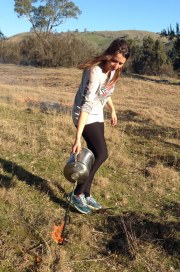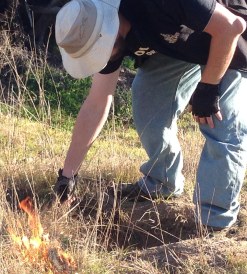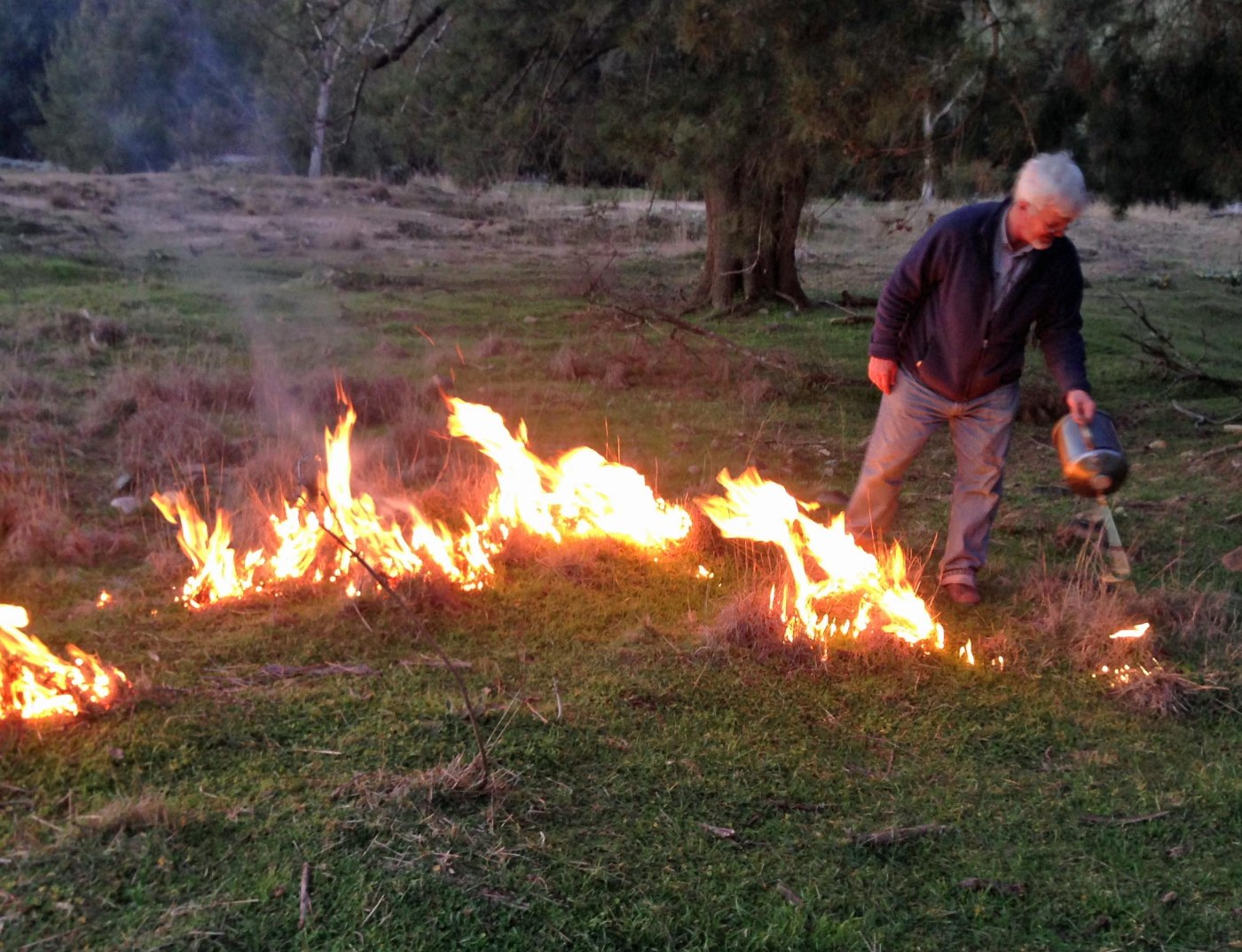Farming, like nature, is messy. It’s nice to see the smooth green grass of spring covering the hills and disguising the rocks. The modern golf course look. Unfortunately, that’s not necessarily what you need either for wildlife or for grazing stock.
Sheep love to have a variety of things to eat, including clovers, grasses, forbs and much else. They will strip unprotected young trees down to their roots in a couple of days, although they’re not such avid browsers as goats. They won’t thrive on dry, tough, stuff, though. And any one of a number of plants that are nutritious as one stage, are poisonous at another.
 The wildlife also need variety to thrive. Earless dragons, for example, tend to do best where they can get between the grass tussocks, and aren’t hemmed in by a thick wall of dry herbage. Many birds and insects that are really beneficial, such as the wasp that parasitizes destructive Christmas beetles, need plants that flower in different seasons to keep them going year-round. Wombats…well, whatever grass they want is usually on the other side of a fence, so they have to tunnel through it.
The wildlife also need variety to thrive. Earless dragons, for example, tend to do best where they can get between the grass tussocks, and aren’t hemmed in by a thick wall of dry herbage. Many birds and insects that are really beneficial, such as the wasp that parasitizes destructive Christmas beetles, need plants that flower in different seasons to keep them going year-round. Wombats…well, whatever grass they want is usually on the other side of a fence, so they have to tunnel through it.
Anyway, biodiversity is the name of the game for me.
Except that some plants don’t want to play that game.
African lovegrass (eragrostis curvula), for example, likes to spread into an impenetrable wall that you can throw yourself at and bounce off again. It rapidly becomes a monoculture of invasion that nothing wants to enter. South of Canberra, around Bredbo, the African lovegrass has taken over a huge area and reduced by two thirds the number of animals (wild or domesticated) that could be supported there.

In different locations, there are different control measures for grazing land. In Bredbo, it would probably be impossible to completely remove the African lovegrass, because it would leave too much of the landscape bare.
Because Bredbo is upstream on the Murrumbidgee to us, the seeds came down to us with the river water. And every year more came. And more. As the river banks have always been a superhighway for weeds, varying one year from California poppies to another with skeleton weed, something that looked like proper grass seemed less of a threat.
 It was clear something was wrong when the lovegrass grew into impenetrable thickets a metre high, because it wasn’t being eaten down. That was particularly so where we fenced out the sheep to plant more trees along the riverbank under a grant from Greening Australia in 1998. The trees did well, but so did the lovegrass.
It was clear something was wrong when the lovegrass grew into impenetrable thickets a metre high, because it wasn’t being eaten down. That was particularly so where we fenced out the sheep to plant more trees along the riverbank under a grant from Greening Australia in 1998. The trees did well, but so did the lovegrass.
What made me realize how much of a threat it is, was the Friends of Grasslands Forum in 2014, where I learned how similar its needs are to Australian native grasses. Unlike many introduced grasses, it doesn’t fade away when inputs like super-phosphate are reduced, it increases. The river banks have few native grasses, but I’d really like to keep African lovegrass away from the hills, where we have many native grasses. Among other things, once it joins them, it’ll be much harder to identify it because there are natives that look a little similar.
As African lovegrass makes very dry, fire-prone clumps, our first efforts at spraying (with either glyphosate or flupropanate) were less than effective at penetrating to the main growth. I’m not keen on using sprays at all, let alone having them be wasted by not working. The solution is to burn it off in the winter and then spray the new, smaller growth in the spring and summer. 
For our two kilometres or so of riverbank, that was lots of lovely fires. Of course, that meant having the right tools, the right weather (little wind, green grass around the lovegrass) and if possible, a good wine and cheese supply. As we know too well, something that can be boringly safe one minute can get out of hand the next, but if it’s done right, it’s both entertaining and effective.




Unlike when I was a child, we no longer burn other things – like dead trees and rotten logs. They used to be considered nuisance rabbit habitat, but since the calici virus reduced the plague numbers of rabbits we keep old wood for lizards and other creatures. Blackberries, similarly, even when dead provide habitat for small birds.

As the amount of lovegrass has reduced substantially in favour of other grasses since we’ve been working on it, the fires in future years will be less exciting, but that’s a small price to pay for getting rid this particular threat.
UPDATE: Sue McIntyre has a more detailed article on African Lovegrass and on grazing patterns in the blog Gang-Gang Gundaroo. It was drawn to my attention in the lead-up to the next Murrumbateman Landcare Meeting on 7 April on the subject of lovegrass.
UPDATE TO THE UPDATE: At the Landcare workshop I learned that there are at least four forms of African Lovegrass, and it’s the thicker, bushier type we have that I think responds most effectively to burning, then spraying. Someone brought in a tuft that had been sprayed last year with glyphosate and regrown around the edges. The suggestion was to combine flupropanate, either as a half dose in the late winter to catch the regrowth and new seedlings, or in combination with glyphosate in summer (again as a half-dose to catch regrowth). That makes sense to me.

Hi Fiona – found your post most interesting, especially since I am now getting more interested in weeds. Did you see my recent post on the dreaded Mouse Ear hawkweed which has become established in the snowy? regards, Barrie
LikeLike
Thanks Barrie. Yes, I find weeds have become a bit of an obsession, although it can get discouraging when you drive past mile after mile of them and can’t do anything about them. I loved your post on the Snowy. We used to go to pony camp at Perisher (back when that was allowed) and I loved all the summer flowers and that Heath-flavoured fresh air. I thought I was following your blog, but obviously wasn’t, but am now. I love your mix of poetry, images and language.
LikeLike
Thanks very much for your interest and kind comments, Fiona. One of these days we should meet up again. I see that it is over two years since were on that course and it must be 18 months since I visited your lovely property. I have been following your blog with interest . Kind regards, Barrie
LikeLiked by 1 person
Fascinating. I wonder if the landowners of Bredbo are planning to do something about the love grass – it would be interesting to know!
LikeLike
Well, for the Bredboans the horse has truly bolted, I think. I understand most graziers there have decided to accept it. I’m not sure about natural parks and wilderness areas. for us, there’s a possibility. It is moving fast, though. It doesn’t establish so easily in places that are fully grassed over, or places that are very fertile. Cattle grazing can keep it in check. Some of the worst areas I’ve seen are the roadside edges in Canberra itself – wherever the mowers go they spread it like crazy.
LikeLike
Thanks for the fascinating post – it is really good to read about wise and active land management for biodiversity. And I was so glad there was a happy ending!
LikeLike
Well, weeds are an ongoing problem. I’m hoping that one day they’ll find a good bio control for African Lovegrass (other than importing elephants).
LikeLiked by 2 people